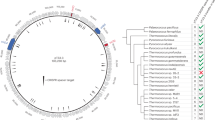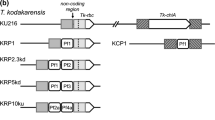Abstract
The replication region of pRD31, a 3.1-kb endogenous plasmid from a marineRhodobacter species, has recently been localized and sequenced. We report here incorporation of this replicon into a narrow-host-range mobilizable pBR325 derivative. This has allowed us to establish an efficient conjugative gene transfer system for a hydrogen-producing marine species ofRhodobacter that is unable to grow aerobically. Efficient transfer was obtained (1.2×10−3 transconjugants per recipient cell), and hybrid plasmids replicated with a high copy number (>10) and good stability. Southern hybridization analysis indicated that the new vectors, pRDP203 and pRDP203s, were maintained in marineRhodobacter sp. NKPB0021 as autonomous replicons without detrimental structural rearrangements, confirming their suitability for use as shuttle vectors.
Similar content being viewed by others
Literature Cited
Burgess JG (1992) Biotechnological applications of photosynthetic bacteria. Trans Mat Res Soc Jpn 10:16–24
Burgess JG, Ashby MK, Hunter CN (1989) Characterization and complementation of a mutant ofRhodobacter sphaeroides with a chromosomal deletion in the light harvesting (LH2) genes. J Gen Microbiol 135:1809–1816
Burgess JG, Miyashita H, Sudo H, Matsunaga T (1991) Antibiotic production by the marine photosynthetic bacteriumChromatium purpuratum NKPB031704: localization of activity to the chromatophores. FEMS Microbiol Lett 84:301–306
Guerry R, LeBlance DJ, Falkow S (1974) General method for the isolation of plasmid DNA. J Bacteriol 116:1064–1066
Johnson JA, Wong WKR, Beatty JT (1986) Expression of cellulase genes inRhodobacter capsulatus by use of plasmid expression vectors. J Bacteriol 167:604–610
Sode K, Tatara M, Takeyama H, Burgess JG, Matsunaga T (1992) Conjugative gene transfer in marine cyanobacteria:Synechococcus sp.,Synechocystis sp. andPseudanabaena sp. Appl Microbiol Biotechnol 37:369–373
Matsunaga T, Matsunaga N, Tsubaki K, Tanaka T (1986) Development of a gene cloning system for the hydrogen producing marine photosynthetic bacteriumRhodopseudomonas sp. J Bacteriol 168:460–463
Matsunaga T, Tsubaki K, Miyashita H, Burgess JG (1990) Chloramphenicol acetyltransferase expression in marineRhodobacter sp. NKPB0021 by use of shuttle vectors containing the minimal replicon of an endogenous plasmid. Plasmid 24:90–99
Matsunaga T, Takeyama H, Sudo H, Oyama N, Ariura S, Takano H, Hirano M, Burgess JG, Sode K, Nakamura N (1991a) Glutamate production from CO2 by marine cyanobacteriumSynechococcus sp. using a novel biosolar reactor employing light diffusing optical fibers. Appl Biochem Biotechnol 28/29:157–167
Matsunaga T, Miyashita H, Miyake M, Burgess JG (1991b) Nucleotide sequence of the replication region of the marineRhodobacter plasmid pRD31. FEBS Lett 283:263–266
Miller L, Kaplan S (1978) Plasmid transfer and expression inRhodopseudomonas sphaeroides. Arch Biochem Biophys 187:229–234
Projan SJ, Carleton S, Novik RP (1983) Determination of plasmid copy number by fluorescence densitometry. Plasmid 9:182–190
Sambrook J, Fritsch EF, Maniatis T (1989) Molecular cloning. A laboratory manual. Cold Spring Harbor, N.Y.: Cold Spring Harbor Laboratory Press
Schmidhauser TJ, Ditta G, Helinski DR (1987) Broad-hostrange plasmid cloning vectors for Gram-negative bacteria. In: Rodriguez RL, Denhardt DT (eds) Vectors: a survey of molecular cloning vectors and their uses. Storhein, Massachusetts: Butterworths, pp 285–332
Scolnik PA, Marrs BL (1987) Genetic research with photosynthetic bacteria. Annu Rev Microbiol 41:703–706
Simon R, Preifer U, Pühler A (1983) A broad host range mobilization system forin vivo genetic engineering: transposon mutagenesis in Gram-negative bacteria. Bio/Technology 1:784–791
Simon R, O'Connell M, Labes M, Pühler A (1986) Plasmid vectors for genetic analysis and manipulation ofRhizobia and other Gram-negative bacteria. Methods Enzymol 118: 640–659
Sistrom WR (1977) Transfer of chromosomal genes mediated by plasmid R68.45 inRhodopseudomonas sphaeroides. J Bacteriol 131:526–532
Strøm T, Raa J (1992) Marine biotechnology in Norway. J Marine Biotechnol, in press
Suwanto A, Kaplan S (1989) Physical and genetic mapping of theRhodobacter sphaeroides 2.4.1 genome: genome size, fragment identification, and gene localization. J Bacteriol 171:5840–5849
Takano H, Takeyama H, Nakamura N, Sode K, Burgess JG, Manabe E, Hirano M, Matsunaga T (1992) CO2 removal by high density culture of a marine cyanobacteriumSynechococcus sp. using an improved photobioreactor employing light diffusing optical fibers. Appl. Biochem. Biotechnol. 34/35: 449–458
Wake H, Akasaka A, Umetsu H, Ozeki Y, Shimomura K, Matsunaga T (1992) Enhanced germination of artificial seeds by marine cyanobacterial extracts. Appl Microbiol Biotechnol 36:684–688
Author information
Authors and Affiliations
Rights and permissions
About this article
Cite this article
Burgess, J.G., Sudo, H., Sode, K. et al. Efficient gene transfer of high copy number mibilizable plasmids containing a marineRhodobacter origin of replication. Current Microbiology 26, 105–108 (1993). https://doi.org/10.1007/BF01577344
Issue Date:
DOI: https://doi.org/10.1007/BF01577344




